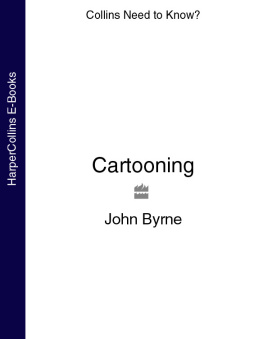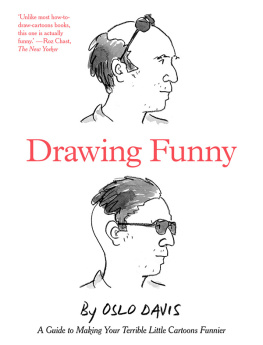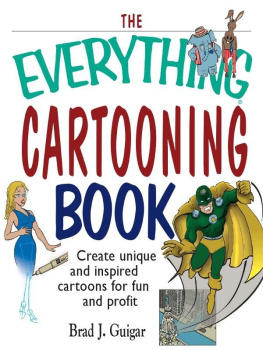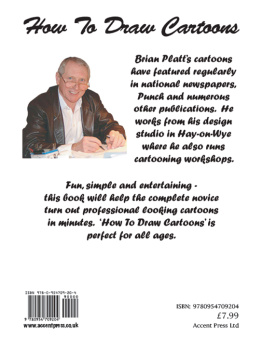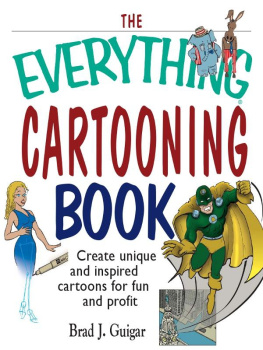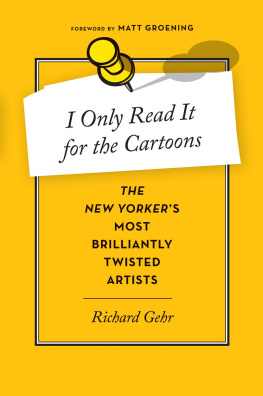David Mostyn was born in Yorkshire in 1944. After finishing school in South Africa, he went to art college and then straight into advertising. He spent ten years as an art director in agencies and studios in London. After a short spell in publishing, he set up as a freelance cartoonist in 1978. He has worked for Mad magazine, The Beano , The Dandy and Marvel Comics , and has illustrated many books, magazines and advertising campaigns. He is married with two children, and lives in Oxford.
MATERIALS AND EQUIPMENT
The range of artists materials currently on the market is overwhelming. Over the years I have spent what must amount to a smallish fortune in paints and pens, some of which have been discarded. However, these werent a waste of money as they helped me to sort out which materials suit my style of artwork.
Before you go to an art shop, try to decide on the kind of work you want to do, then concentrate on finding the materials that will be suitable for it. Inevitably you will buy some products that you find dont work for you, and as you progress, like me, you will discard equipment along the way. The most important point to remember is that there are no hard and fast rules in the cartoon industry on what you may use as your drawing tools.
My equipment is very simple, and I describe here what I use and why.
Paper
There are basically two types of paper surface suitable for drawing cartoons: Hot Pressed (HP) and NOT, sometimes termed Cold Pressed (CP). NOT paper can be quite rough to the touch and has a definite texture, while HP paper has a smooth surface. Some brands of paper are obtainable in both forms.
Because you may want to draw in different styles and mediums, in black and white and in colour too, its useful to find a brand of paper that suits all these things. Fabriano paper is suited to just about everything you can throw at it, both literally and figuratively. Leonardo da Vinci used it, and I feel that whats good enough for him is good enough for me!

I favour Fabriano 5, which comes in both HP and NOT surfaces; which you choose depends on your individual style. A weight of 300gsm (140lb) is excellent when it comes to supporting heavy inking and colour. It is reasonably priced, and if you can buy it in bulk, so much the better. Fabriano also has excellent see-through qualities which you will find useful.
Bristol board is a very smooth, hard paper ideal for more diagrammatic fine-line black and white cartoons, but its not very good for colour. For ideas and roughs, I draw on very cheap 80gsm (20lb) paper. Experiment with different papers and youll soon find out how their surfaces react with different drawing tools.

Pens
There are several different types of pen available, all with their own characteristic marks. I use felt-tip pens a great deal as they are excellent to draw with. They are easily available and inexpensive, but make sure you buy the waterproof variety.

Dip pens are the old-fashioned type of pen, where you insert a nib into the ink holder. They can be tricky to use at first, but with practice you can draw wonderfully variable lines with them. A 303 nib is a good standard nib to begin with. Make sure you use waterproof ink.
Rapido pens are generally used to draw detailed diagrams or fine line work. They produce a line of even width and are available in different thicknesses.

Pencils
Pencils are sold in varying grades from 6H (the hardest) to 6B (the softest). As you might expect, HB falls in the centre. The grade is indicated at the non-business end of a pencil (when you sharpen your pencil, please remember to do it at the opposite end!) I always use a 4B, which gives a good black line.

Parallel rulers
These are mostly found on the larger drawing boards such as you might find in an architects office. However, some years ago I discovered a small plastic 300mm parallel ruler that is ideal for putting in guidelines and drawing reasonably accurate square boxes. It looks a bit gimmicky, but it really is very effective, and now I cant work without one. They are available in most art supplies shops, and are very reasonably priced.

Erasers
Putty erasers are the only kind to use they are very soft and will remove pencil marks from the paper without damaging the surface. Inflexible school erasers will spoil it.

Brushes
Brushes come in varying sizes and types of hair. At the top end of the market, sable brushes are the best and most expensive. I have never bought them because as a cartoonist I use a great deal of black ink and however hard I might try to keep them clean, a residue of ink would build up in them and eventually make them unusable. Instead, I lean towards the synthetic type of brush. They dont retain as much water but they are a great deal cheaper than their aristocratic chums and perform just as well.
The size of a brush is indicated by a number the lower the number, the smaller the brush. For everyday purposes I use a No.1 and No. 5 round brush, though when it comes to putting on larger areas of wash its better to use one from No. 8 upwards. I find the very fine point that round brushes have gets in the way, so I trim the brush with a scalpel blade, cutting it on a very hard surface. Although the piece removed is minuscule, I find the brush easier to control. I have two sets of brushes, one for colour and the other for black and white.

Coloured mediums
Colouring cartoons is entirely different to painting a picture on canvas or board. Cartoon colour tends to be bright, sharp and very hard, and should be water-based for fast drying. The traditional watercolour pans give a good clear colour but tend to be rather weak; inks and dyes give a much crisper result. I use inks, which dilute very evenly and arent too quick-drying. Some colours have to be diluted with distilled water because if you use ordinary tap water the colour separates out and will leave a sediment on the paper.
Acrylics come in a splendid range of brands and colours. They do tend to dry very quickly, and are more suited to a painterly approach as opposed to the normal wash technique. Marker pens, available in a huge range of colours, are ideal for doing colour roughs, or for more casually drawn cartoons. Crayons are not much found in cartoons, but they can give a wonderfully soft effect and are generally used in childrens publications.
If you progress to drawing cartoons professionally, one very important point to remember is to use a long-established manufacturer. For example, if you are doing a long-running cartoon strip you might have trouble finding similar colours in the event that your manufacturer ceases production.
Next page

